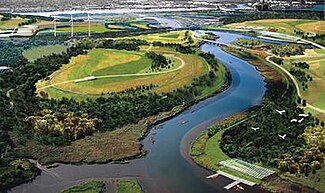Freshkills Park
| Freshkills Park | |
|---|---|

An illustration of the future Freshkills Park
|
|
| Type | Public park |
| Location |
Fresh Kills Landfill site, Staten Island, New York City, United States |
| Nearest city | New York City |
| Coordinates | 40°34′52″N 74°11′21″W / 40.581°N 74.1892°WCoordinates: 40°34′52″N 74°11′21″W / 40.581°N 74.1892°W |
| Area | 2,200 acres (8.9 km2) |
| Created | 2008 |
| Operated by | New York City Department of Parks and Recreation |
| Open | 2012 (partial) 2035-37 (full) |
| Website | Official website |
Freshkills Park is a public park being built atop a landfill reclamation project on Staten Island. About 2,200 acres (8.9 km2), it will be the largest park developed in New York City since the 19th century. Its construction began in October 2008 and is slated to continue in phases for at least 30 years. When fully developed by 2035-37, Freshkills Park will be the second-largest park in New York City and 2.7 times the size of Central Park in Manhattan. The park has been designed for five major sections that accommodate a range of uses, including cultural, athletic, and educational programs. Sections of the park will be connected by a circulation system for vehicles and a network of paths for bicyclists, pedestrians, and equestrians. The New York City Department of Parks and Recreation (NYC Parks) is running the project with the New York City Department of Sanitation.
The landfill opened in 1947 in what was then a salt marsh in a rural agricultural area. The subsoil was made up of clay, with sand and silt as the top layer of soil. The land still contains large amounts of wildlife within the boundaries of the landfill. There were tidal wetlands, forests, and freshwater wetlands. The area, being in a swamp and wetlands, was prime for the landfill, being far removed from the rest of New York City at the time (Staten Island's connection to the rest of the city in 1947 was by ferry).
The initial plan for a temporary landfill called for Fresh Kills to be used for 20 years, then developed as a multiuse area with residential, recreational, and industrial components. At the peak of its operation, the contents of twenty barges – each carrying 650 tons of garbage – were added to the site every day. The landfill was by then the world's largest man-made structure.
In 2001 it was estimated that, if kept open, the landfill would have eventually become the highest point on the East Coast. Under local pressure and with support of the United States Environmental Protection Agency (EPA), the landfill site was closed on March 22, 2001, but it was soon reopened due to the September 11 attacks on the World Trade Center in Manhattan in 2001. Virtually all the wreckage and debris, including all remains of the dead that were not detected at the recovery site, had to be sent to the temporarily reopened landfill for examination. Thousands of detectives and forensic evidence specialists worked for over 1.7 million hours at Fresh Kills Landfill to try to recover remnants of the 2,749 people killed in the attacks. A final count of 4,257 human remains were recovered. From those, 300 people were identified; the City's Chief Medical Examiner retains custody of all still-unidentified remains at a facility within the National 9/11 Memorial in Manhattan. A memorial is being built to honor those who were not able to be identified in all of the debris from the attack. The debris was then buried in a 40-acre (160,000 m2) portion of the landfill; it is highly likely that this debris still contains undetected, fragmentary human remains. Afterward, the landfill facility was closed permanently, in anticipation of the park on the site.
...
Wikipedia
